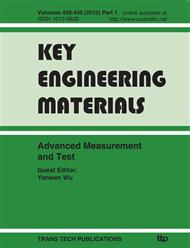[1]
N. E. Huang et. al.: The empirical mode decomposition and the hilbert spectrum for nonlinear and non-stationary time series analysis, Proc. R. Soc. Lond. A, vol. 454, pp.903-995, Mar. (1998).
DOI: 10.1098/rspa.1998.0193
Google Scholar
[2]
Huang NE, Shen Z, Long S R, et al: A new view of nonlinear waves: The Hilbert spectrum, Annual Review of Fluid Mechanics, 417-457 (1999).
DOI: 10.1146/annurev.fluid.31.1.417
Google Scholar
[3]
M. Bamsley, Fractah Eveywbere: Academic Press, Inc., London.
Google Scholar
[4]
K. Semion, P. Thomas, Flatley, etc: On the Hilbert-Huang Transform Data Processing System Development. IEEE Aerospace Conference Proceedings, pp.1961-1979, (2004).
Google Scholar
[5]
C. Moler: Numerical Computing with Matlab. Society for Industrial and Applied Mathematics, (2004).
Google Scholar
[6]
Long Si sheng, Zhang Tie long, Long Feng. The causes and solutions for fitting overshoot and endpoint flying wing in Hilbert-Huang Transformation. ACTA SEISMOLO GICA SINICA Vol. 27, No. 5, 561-568.
Google Scholar
[7]
N. E Huang, Z. Shen and S.R. Long et al, The empirical mode decomposition and the Hilbert spectrum for nonlinear and non-stationary time series analysis, Proceeding of Royal Society London, Series A. Vol. 454, 903-995, (1998).
DOI: 10.1098/rspa.1998.0193
Google Scholar
[8]
Huang NE, Wu M, Long S R, et al. A confidence limit for the empirical mode decomposition and Hilbert spectral analysis, Proc. R. Soc, Lond. 2003, A 459: 2317-2345.
DOI: 10.1098/rspa.2003.1123
Google Scholar
[9]
P. Flandrin, Some aspects of Huang's empirical mode decomposition, from interpretation to applications, presented at the Int. Conf. Computational Harmonic Analysis (Invited Talk), Nashville, TN, (2004).
Google Scholar
[10]
M. Datig and T. Schlurmann, Performance and limitations of the Hilberthuang transformation (HHT) with an application to irregular water waves, , Ocean Engineering, Vol. 31, pp.1783-1834, (2004).
DOI: 10.1016/j.oceaneng.2004.03.007
Google Scholar
[11]
LIU Hui-Ting , NI Zhi- Wei, Clustering Method of Time Series Based on EM D and K-means Algorithm , PR & AI, VOL. 22, P803-808, (2009).
Google Scholar
[12]
WANG Ting , YANG Shen-yuan , LI Bing-bing, A New Method for End Effect of EMD, JOURNAL OF HARBIN UNIVERSI TY 0F SCIENCE AND TECHNOIDGY, VOL . 14, P23-26, (2009).
Google Scholar


